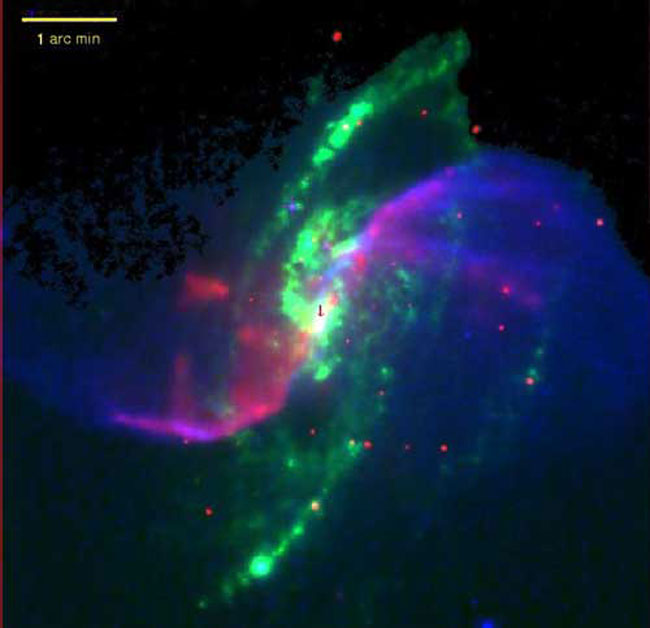Galaxy's Ghostly Arms Finally Explained

Scientists have discovered the source of a galaxy's two extra, ghostly spiral arms that show up only in some telescope images, cracking a 45-year-old mystery.
M106 (also known as NGC 4258), a stately spiral galaxy 23.5 million light-years away in the constellation Canes Venatici, appears in visible light images to have just two prominent arms emanating from its nucleus and spiraling outward.
"But in radio and X-ray images, two additional spiral arms dominate the picture, appearing as ghostly apparitions between the main arms," said Andrew Wilson, part of a University of Maryland team of astronomers that used data from four space telescopes to arrive at an explanation of the strange phenomenon.
The "anomalous arms" consist mostly of regions of gas that are being violently heated by shock waves from a pair of jets of particles originating at the galaxy's core, said Yuxuan Yang, who headed up the research, which will be detailed in the May 10 issue of the Astrophysical Journal.
In 2001, Wilson, Yang and Gerald Cecil of the University of North Carolina, Chapel Hill, noted that the jets are tipped 30 degrees with respect to the galaxy disk. If one could vertically project the jets down onto the disk, they would line up almost perfectly with the anomalous arms.
Wilson and Yang decided this was unlikely a random finding and proposed that the jets heat gas in their line of travel, forming an expanding cocoon that heats gas in the relatively nearby disk of M106 to millions of degrees, generates shock waves and causes the gas to radiate brightly in X-rays and other invisible wavelengths.
The team tested this idea by looking at archived observations from the European Space Agency's XMM-Newton X-ray observatory to measure the gas temperature in the anomalous arms and see how strongly X-rays from the gas are absorbed en route by intervening material.
Get the Space.com Newsletter
Breaking space news, the latest updates on rocket launches, skywatching events and more!
"One of the predictions of this scenario is that the anomalous arms will gradually be pushed out of the galactic disk plane by jet-heated gas," said Yang in a prepared statement.
The XMM-Newton data showed that the X-rays are more strongly absorbed in the direction of the northwest arm than in the southeast arm, strongly suggesting that the southeast arm is partly on the near side of M106's disk and the northwest arm is partly on the far side.
These findings are consistent with the scenario proposed by Wilson and Yang, and they were confirmed by other data from NASA's Spitzer Space Telescope and its Chandra X-ray Observatory. Hubble telescope data also were brought to bear on the question.
This article is part of SPACE.com's weekly Mystery Monday series.
- Top 10 Strangest Things in Space
- Image Gallery: Chandra's First Two Years
- X-Ray Astronomy: 40 Years of Seeing the Invisible
Join our Space Forums to keep talking space on the latest missions, night sky and more! And if you have a news tip, correction or comment, let us know at: community@space.com.

Robin Lloyd was a senior editor at Space.com and Live Science from 2007 to 2009. She holds a B.A. degree in sociology from Smith College and a Ph.D. and M.A. degree in sociology from the University of California at Santa Barbara. She is currently a freelance science writer based in New York City and a contributing editor at Scientific American, as well as an adjunct professor at New York University's Science, Health and Environmental Reporting Program.









